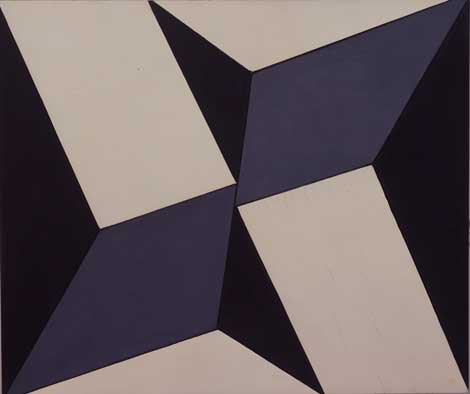“The Abandonment of Art, 1948–1988” at MoMA showcases more than 300 pieces by the groundbreaking Brazilian artist Lygia Clark whose ultimate emphasis was on the sensorial experience of art. Altering the viewer’s perception and experience of her objects permeates through her work from its very inception in the 1950s.
Clark’s early paintings that were influenced by Piet Mondrian and Kazimir Malevich reveal her interest in the defining qualities of geometry’s shapes and delineated spaces. She began expanding the boundaries of her structures by demarcating blocks in such a way that it formed another visible dimension to her process. For example, in Breaking the Frame, (P x B) version 01 (1954), a new language is evidenced from the lines dividing the inner and outer rectangular shapes in the painting that visibly sets them apart on the canvas.

Lygia Clark: Planes in modulated surface no. 2, version 1. c. 1957, photo Eurides Lula Rodrigues Cardoso, Courtesy Associação Cultural “O Mundo de Lygia Clark
Her works reach a different plane in the black-and-white collages of the late ’50s and early ’60s. Termed as Neo-Concrete art that Clark devised with other Brazilian artists such as Helio Oiticica, it placed an emphasis on three-dimensionality and movement. Influenced by the optical illusions created by the work of Bridget Riley and Victor Vasarely, Clark’s focus was on experiencing space from a more visceral perspective. In the series of paper works titled Study for Planes on Modulated Surface and Planes on Modulated Space made between 1957–59, her ingenious combination of geometric shapes contrives a sense of depth and movement that constantly shifts between its static and non-static qualities. The viewer is drawn to the mutability and movement of the surface thereby creating immediate interactivity between the art object and spectator. For Clark, viewer participation was paramount to her practice, and the tangible quality of her art set it apart both visually and experientially.

Lygia Clark, Superfície modulada no. 9 (Modulated surface no. 9), 1957. Courtesy Associação Cultural “O Mundo de Lygia Clark,”
Clark’s ongoing interest and fascination with architecture led to the construction of her geometric metal sculptures known as Bichos. In Fantastic Architecture (1963), that resembles an origami paper cut out, the pieces are flexible and enable easy maneuverability quite contrary to one’s expectations of metal sculpture. Joined by hinges akin to the spinal cord that holds the body together, the Bichos are devoid of a right or wrong side. Linear (1960) appears to be endlessly interchangeable, and viewers are encouraged to manipulate the sculpture while exploring its alterable possibilities. Like modulated surface paintings, Clark’s Bicho’s present what the art historian Guy Brett refers to as a “dialectic of physical qualities such as heaviness and lightness, fullness and emptiness, warmth and cold, light and dark” which are experienced by the audience. Metallic and at once flimsy, structured and at once works that can be dismantled—these dichotomies and fluidities of her sculpture foresee the next phase of her therapeutic healing art in which soft, pliable materials were meant to be worn.
The final stage of Clark’s art making process comprised of her “propositions,” wherein the art object became the intermediary of an experience offered by the proponent. Supple materials such as Sensorial Gloves (1968) were conceived to enhance the experience of unlocking pre-verbal memories.
At the end, regardless of the components, Clark’s place as a visionary and advocate of tactile art is confirmed by this exhibition.
Lygia Clark runs through August 24, 2014;
Museum of Modern Art, New York; moma.org


